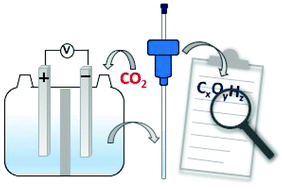当前位置:
X-MOL 学术
›
Dalton Trans.
›
论文详情
Our official English website, www.x-mol.net, welcomes your
feedback! (Note: you will need to create a separate account there.)
Manifesto for the routine use of NMR for the liquid product analysis of aqueous CO2 reduction: from comprehensive chemical shift data to formaldehyde quantification in water.
Dalton Transactions ( IF 3.5 ) Pub Date : 2020/02/25 , DOI: 10.1039/c9dt04749b Tamal Chatterjee 1 , Etienne Boutin 1 , Marc Robert 1
Dalton Transactions ( IF 3.5 ) Pub Date : 2020/02/25 , DOI: 10.1039/c9dt04749b Tamal Chatterjee 1 , Etienne Boutin 1 , Marc Robert 1
Affiliation

|
CO2 reduction research is at a critical turnaround since it has the potential to partially or even substantially fulfil future clean energy needs. CO2-to-CO electrochemical conversion is getting closer from industrial implementation requirements. Efforts are now more and more directed to obtain highly reduced products such as methanol, methane, ethylene, ethanol, etc., most of them being liquids. Gas-phase products (e.g., CO, CH4) are typically detected and quantified by well-defined gas chromatography (GC and GC/MS) protocols. On the other hand, NMR, GC-MS, HPLC have been used for the liquid phase characterization, but no routine technique has yet been established, mainly due to lack of versatility of a single technique. Additionally, except NMR and GC-MS, classical techniques cannot distinguish 13C from 12C products, although it is a mandatory step to assess products origin. Herein, we show the efficiency and applicability of 1H NMR as routine technique for liquid phase products analysis and we address two previous shortcomings. We first established a comprehensive 1H and 13C NMR chemical shifts list for all 12CO2 and 13CO2 reduction products in water ranging from C1 to C3. Then we overcame the difficulty of identifying aqueous formaldehyde intermediate by 1H NMR through an efficient chemical trapping step, along with isotopic signature study. Formaldehyde can be reliably quantified in water with a concentration as low as 50 μM.
中文翻译:

常规用于将NMR用于减少CO2水溶液的液体产物分析的宣言:从全面的化学位移数据到水中的甲醛定量分析。
减少二氧化碳的研究正处于关键的转变,因为它有可能部分或什至基本满足未来的清洁能源需求。从CO2到CO的电化学转化越来越接近工业实施要求。现在越来越多地努力获得高度还原的产物,例如甲醇,甲烷,乙烯,乙醇等,其中大多数是液体。气相产物(例如,CO,CH4)通常通过定义明确的气相色谱(GC和GC / MS)方案进行检测和定量。另一方面,NMR,GC-MS,HPLC已用于液相表征,但主要由于缺乏单一技术的多功能性,尚未建立常规技术。此外,除了NMR和GC-MS,传统技术无法区分13C和12C产品,尽管这是评估产品来源的强制性步骤。在这里,我们展示了1H NMR作为液相产物分析的常规技术的效率和适用性,并且我们解决了之前的两个缺点。我们首先为水中从C1到C3的所有12CO2和13CO2还原产物建立了一个全面的1H和13C NMR化学位移列表。然后,我们通过有效的化学捕集步骤以及同位素标记研究,克服了通过1 H NMR鉴定甲醛水溶液中间体的困难。可以低至50μM的浓度对水中的甲醛进行可靠的定量。我们首先为水中从C1到C3的所有12CO2和13CO2还原产物建立了一个全面的1H和13C NMR化学位移列表。然后,我们通过有效的化学捕集步骤以及同位素标记研究,克服了通过1 H NMR鉴定甲醛水溶液中间体的困难。可以低至50μM的浓度对水中的甲醛进行可靠的定量。我们首先为水中从C1到C3的所有12CO2和13CO2还原产物建立了一个全面的1H和13C NMR化学位移列表。然后,我们通过有效的化学捕集步骤以及同位素标记研究,克服了通过1 H NMR鉴定甲醛水溶液中间体的困难。可以低至50μM的浓度对水中的甲醛进行可靠的定量。
更新日期:2020-04-08
中文翻译:

常规用于将NMR用于减少CO2水溶液的液体产物分析的宣言:从全面的化学位移数据到水中的甲醛定量分析。
减少二氧化碳的研究正处于关键的转变,因为它有可能部分或什至基本满足未来的清洁能源需求。从CO2到CO的电化学转化越来越接近工业实施要求。现在越来越多地努力获得高度还原的产物,例如甲醇,甲烷,乙烯,乙醇等,其中大多数是液体。气相产物(例如,CO,CH4)通常通过定义明确的气相色谱(GC和GC / MS)方案进行检测和定量。另一方面,NMR,GC-MS,HPLC已用于液相表征,但主要由于缺乏单一技术的多功能性,尚未建立常规技术。此外,除了NMR和GC-MS,传统技术无法区分13C和12C产品,尽管这是评估产品来源的强制性步骤。在这里,我们展示了1H NMR作为液相产物分析的常规技术的效率和适用性,并且我们解决了之前的两个缺点。我们首先为水中从C1到C3的所有12CO2和13CO2还原产物建立了一个全面的1H和13C NMR化学位移列表。然后,我们通过有效的化学捕集步骤以及同位素标记研究,克服了通过1 H NMR鉴定甲醛水溶液中间体的困难。可以低至50μM的浓度对水中的甲醛进行可靠的定量。我们首先为水中从C1到C3的所有12CO2和13CO2还原产物建立了一个全面的1H和13C NMR化学位移列表。然后,我们通过有效的化学捕集步骤以及同位素标记研究,克服了通过1 H NMR鉴定甲醛水溶液中间体的困难。可以低至50μM的浓度对水中的甲醛进行可靠的定量。我们首先为水中从C1到C3的所有12CO2和13CO2还原产物建立了一个全面的1H和13C NMR化学位移列表。然后,我们通过有效的化学捕集步骤以及同位素标记研究,克服了通过1 H NMR鉴定甲醛水溶液中间体的困难。可以低至50μM的浓度对水中的甲醛进行可靠的定量。











































 京公网安备 11010802027423号
京公网安备 11010802027423号